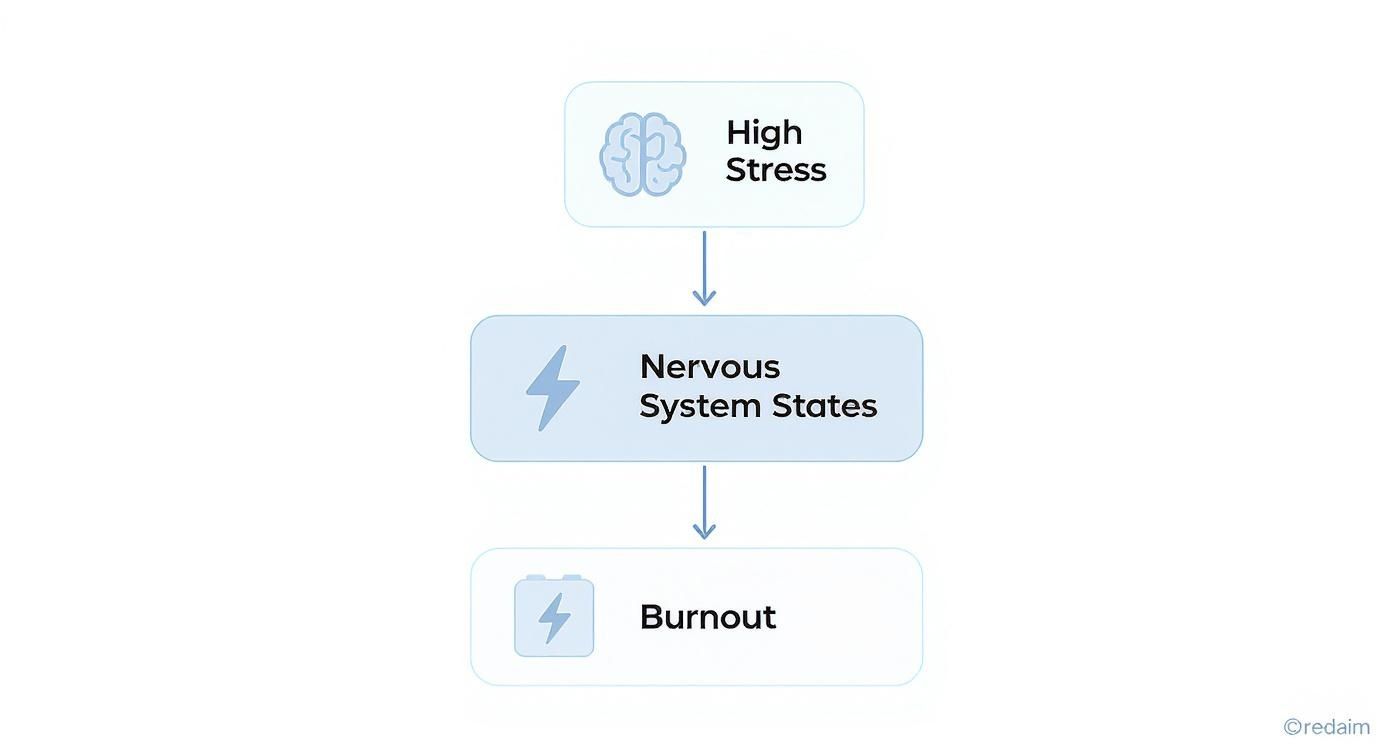
Beyond the Burnout: The New Era of Women's Leadership Development Programs
You’ve checked every box. Earned every promotion. You’ve built a career that, from the outside, looks like the very definition of success. And yet, there’s a quiet, persistent exhaustion that follows you home. A feeling that your capacity is finite, your energy borrowed, and if you stop performing for even a moment, you might just disappear. This isn't just fatigue; it's the silent collapse of an operating system pushed beyond its biological limits.
Key Takeaways
The System is Flawed, Not You: Traditional women's leadership development programs often accelerate burnout by focusing on external skills while ignoring the biological reality of chronic stress and nervous system dysregulation.
Leadership is Biological: Your ability to think strategically, inspire teams, and make clear decisions is directly controlled by your nervous system. Sustainable leadership requires mastering your internal state, not just your schedule.
From Burnout to Sovereignty: The RAMS™ Method (Results, Attitude, Mastery, Systems) offers a new operating system for leaders, focusing on rebuilding your capacity from the inside out for unshakable resilience.
The Path Back to You: True leadership development isn't about adding more to your plate. It's about returning to an authentic, embodied way of leading that energizes you instead of draining you.
Effective women's leadership development programs are evolving beyond surface-level skills to address the root cause of executive burnout: nervous system dysregulation. The new paradigm focuses on embodied, somatic practices that build true resilience, enabling leaders to manage immense pressure without sacrificing their well-being. This shift from performance-based training to a biology-first approach is the key to creating sustainable and authentic leadership.
The Hidden Pattern of Collapse

This feeling—the growing chasm between external achievement and internal depletion—is the silent collapse. It's the kind of exhaustion that coffee can't fix and a vacation can't cure. You’re leading teams and driving results, but the cost is a constant, low-grade hum of activation in your nervous system.
This isn't a personal failing; it’s a systemic one.
Many women's leadership development programs were designed for a different era. They teach you how to build a skyscraper but never show you how to check the foundation for cracks. They are the equivalent of adding more high-performance software to a computer whose hard drive is failing—it only accelerates the inevitable crash.
The Widening Gap in Leadership
Despite decades of initiatives, the gap at the top remains stubbornly wide. The World Economic Forum reports that women's representation in top leadership roles has actually declined for the third consecutive year.
Globally, women make up 43.4% of the workforce but hold only 30.6% of leadership positions. This disparity signals a critical failure in traditional approaches, which often overlook the root causes of burnout that push incredibly talented women out of the leadership pipeline.
The internal dialogue of the high-achieving woman is often a relentless self-assessment. “If I just work harder, get more efficient, or learn one more framework, I can finally get ahead of it.” But the problem isn't a lack of skill or ambition. The real issue is running an operating system that's been pushed far beyond its biological limits.
For so many, this experience is a direct path to a state of complete exhaustion. It’s a phenomenon we explore deeply in our guide to working mother burnout. The cycle of pushing through eventually leads not to a breakthrough, but to a breakdown.
The RAMS Reframe
Most women's leadership development programs are built on a flawed, outdated premise. They treat leadership as a collection of skills to be downloaded negotiation tactics, strategic planning, public speaking. While useful, these are only pieces of a much larger puzzle.
The fundamental problem: they teach you what to do but ignore how you show up to do it. These programs fail to address the underlying nervous system patterns that dictate your capacity, resilience, and decision-making under fire. It’s like designing a magnificent skyscraper but building it on a seismic fault line. The unstable ground of a dysregulated nervous system guarantees an eventual collapse.
This oversight isn't just ineffective it's actively harmful, often accelerating burnout instead of preventing it.
Reinforcing a Vicious Cycle of Burnout
Ironically, traditional programs often reinforce the very patterns that drive high-achieving women into exhaustion. They become another checklist, another set of impossible standards to meet perfectly.
This focus on external performance amplifies the internal drivers of burnout:
Perfectionism: The drive to execute every new skill flawlessly, piling more pressure onto an overloaded system.
Hyper-vigilance: A constant state of high alert, scanning for threats, which keeps the nervous system locked in fight-or-flight.
Intellectualization: Relying solely on logic and strategy, disconnecting you from your body’s wisdom and the early warning signs of stress.
Instead of creating sustainable leaders, these programs provide more sophisticated tools to mask a system heading for overload.
The real work of leadership isn’t about layering more skills on top of a stressed-out system. It's about rebuilding the system itself so it can handle immense pressure without fracturing.
The Missing Piece is Somatic
The core issue is that these programs are designed for the cognitive mind, not the whole person. They ignore the body and the nervous system where stress, trauma, and burnout are physically stored.
Without addressing this somatic reality, any new skill is temporary. A leader can memorize an advanced negotiation strategy, but if her nervous system floods with cortisol in a high-stakes meeting, she'll revert to primal fight, flight, or freeze responses. Her body will always override her intellect.
True leadership development must be embodied. It must teach you how to regulate your internal state first, creating a solid foundation of calm and clarity from which to lead. This is the central idea behind the revolutionary RAMS Method framework. The focus shifts from simply doing more to fundamentally changing your way of being.
Comparing Traditional vs. Embodied Leadership Programs
To grasp the difference, it helps to see the two philosophies side-by-side. The old way is worlds apart from a modern, embodied approach.
AttributeTraditional Programs (The Old Way)Embodied Programs (The New Way)
Primary Focus Skill acquisition and external behaviorsNervous system regulation and internal state
Core Method Information transfer (lectures, frameworks)Somatic practices and experiential learning
Goal Improve performance and effectivenessBuild resilience and sustainable capacity
View of Burnout A problem of time management or mindsetA physiological state of nervous system dysregulation
Outcome Temporary behavioral changes under pressureLasting shifts in presence, decision-making, and calm
One approach adds tools to a potentially fragile structure; the other rebuilds the foundation entirely.
Introducing a New Operating System for Leaders: The RAMS™ Method
The relentless cycle of achievement and exhaustion isn't a leadership problem; it's an operating system failure. The old software running on external validation, intellectual brute force, and sheer willpower—is crashing. It’s time for an upgrade.
This new system, the RAMS™ Method, puts your internal state first. It recognizes a fundamental truth: your capacity to think clearly, inspire others, and make powerful decisions is a direct result of your biological state.
Results (R): Get radically clear on what you truly want, stripping away societal "shoulds." Define success on your own terms not just hitting KPIs, but creating outcomes aligned with your values.
Attitude (A): Master your internal state through nervous system regulation. This is the practical, somatic work of learning how to shift from reactive stress to grounded presence.
Mastery (M): Embody your unique genius. Move beyond performing a role into a state where your actions are an effortless expression of your deepest strengths.
Systems (S): Create external structures that protect your energy and amplify your impact. These are the boundaries, support networks, and routines that make your internal stability sustainable.
These pillars aren't a checklist; they're a dynamic architecture. Your ability to create meaningful Results is directly tied to your Attitude. Embodying your Mastery is impossible without robust Systems to support you.
Building from the Biology Up
Most leadership models fail because they ignore the biological hierarchy of stress and burnout.

This image shows that burnout isn't the problem. It’s the final, predictable symptom of an overloaded system. By focusing on your nervous system state (your Attitude), you interrupt this biological cascade at the source. This is the fundamental shift from symptom management to root-cause resolution, working with your biology, not against it. To start reclaiming your energy, our guide on how to recover from burnout is the first step.
How to Choose a Program That Creates Real Change
Choosing the right women's leadership development program isn't just about the financial investment; it's an investment of your energy, time, and hope. The wrong program can reinforce the very habits—like perfectionism and over-functioning—that lead to burnout.
Use this checklist to find a program that delivers deep, lasting change:
Does it address the nervous system? This is the single most important question. If a program isn't explicitly talking about nervous system regulation or somatic work, it’s ignoring the biological root of stress.
Is it based on somatic principles? An effective program teaches you how to work with the physical sensations of stress in your body, giving you tangible tools to self-regulate in the moment.
Does it offer personalized coaching? One-size-fits-all curricula can't touch the unique internal patterns of each leader. Prioritize individualized support.
Are there proven, verifiable case studies? Hunt for evidence of genuine, lasting transformation stories of fundamental shifts in how these leaders experience their work and lives.
The structure of a program has a huge impact. Self-paced online courses rarely provide the accountability for real change. Look for programs using a dynamic cohort-based learning model balanced with deep, one-on-one coaching for both community connection and tailored breakthroughs. For more on what effective leadership support looks like, explore our article on real support for leaders.
ACT III: The Return to Yourself
The real purpose of a powerful women's leadership development program isn't to make you a better executive for your company. It is to return you to yourself.
It’s about reclaiming a way of leading that feels authentic, grounded, and clear a style that energizes you instead of draining you. This is the heart of leadership sovereignty: the freedom to lead powerfully without the constant threat of burnout. It means you can navigate immense pressure not by bracing for impact, but by maintaining a centered and regulated internal state. True leadership isn’t about the title you hold; it’s about the nervous-system sovereignty you bring into every room.
From Performance to Sovereignty
Making the shift from a performance-driven mindset to one of sovereignty is the final, most critical step. The old model demands you constantly prove your worth through relentless action. The new model invites you to lead from a place of innate value, where your impact flows naturally from who you are.
The real measure of success isn't another promotion. It's the quiet confidence that you can handle whatever comes your way without sacrificing your well-being. It is the return to nervous-system sovereignty.
Your Path Back to You
This journey back to your authentic self is the most important work any leader can do. When evaluating programs, look for modern approaches that incorporate strong principles of DEI in Leadership, which foster inclusive and authentic environments.
The invitation now isn't to another program promising to fix you, but to a process that helps you remember the powerful, centered leader you already are the leader you were before the burnout took hold. It's a path to build an internal foundation strong enough to support not just your career, but your entire life. This intentional design is a cornerstone of what we call Leadership Sovereignty Mastery a state where you are in conscious control of both your internal and external worlds.
Ready to map out your personalized path back to your innate power? The next step isn't a sale. It is a step toward returning to yourself.
Are you ready to stop managing burnout and start building a truly sustainable leadership practice?
The team at Baz Porter helps accomplished women leaders move from a state of exhaustion to one of embodied power.
Book a diagnostic call today to discover your path to leadership sovereignty.
